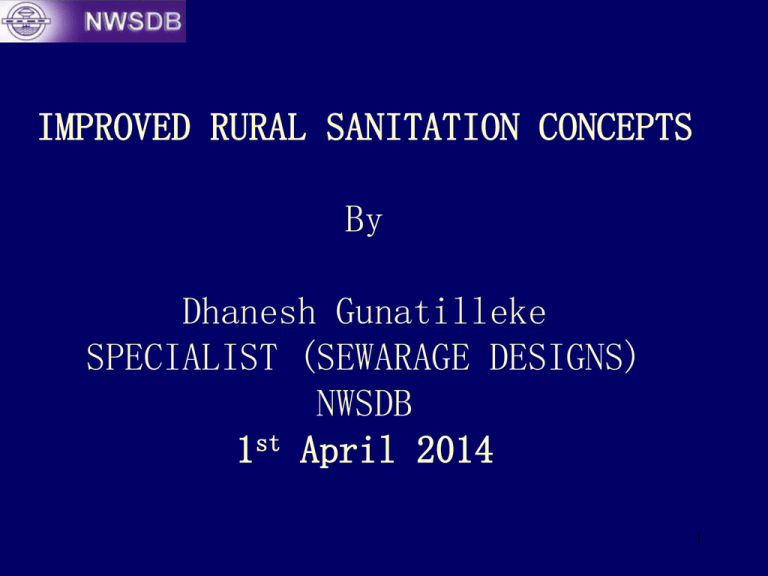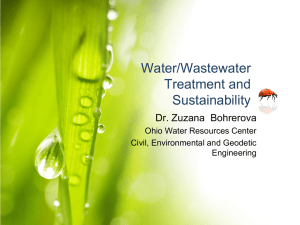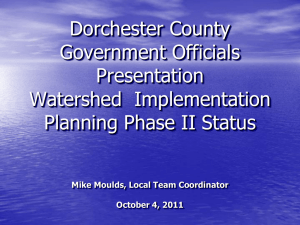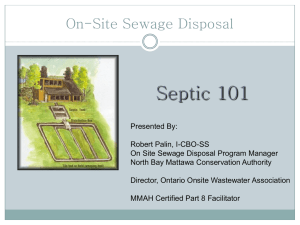
IMPROVED RURAL SANITATION CONCEPTS
By
Dhanesh Gunatilleke
SPECIALIST (SEWARAGE DESIGNS)
NWSDB
1st April 2014
1
Presentation Outline
1
Why wastewater treatment?
2
Policy on Wastewater Separation
3
Types of sanitation systems
4
Design of onsite sanitation systems in compliance to
SLS 745 Part II:2009
5
Further Treatment Options
2
2
1 WHY WASTEWATER TREATMENT ?
Protect the environment from;
high loads of suspended solids & organic matter
eutrophication & groundwater pollution
Substantial load of hazadous and non biodegradable compounds
Serious contamination with microorganisms
…in order to
establish/maintain healthy environment for flora & fauna
allow mankind to use water resources for different purposes
prevent transmission of waterborne diseases/improve public health
3
4
Definition of Safe Sanitation
Collection, Transport, Treatment &
Disposal or reuse of human excreta,
domestic wastewater and solid waste,
and associated hygiene promotion
Ref: water supply and sanitation collaborative council
5
6
7
8
9
Pollution from human beings
45-60 g BOD/person/day
8- 14 g N/person/day
0.6-2.5 g P/person/day
Virus
Medical residues
10
Eutrophication & it’s impacts
Increase in rate of supply of organic matter
to an ecosystem resulting nutrient built up
(N, P)
Massive algae growth, anaerobic
conditions, oxygen depletion
Changers in the structure and functioning of
the lake and marine ecosystem
Reduction in biodiversity, fish and shellfish
harvesting
Increase risk of poisoning by algal toxins
11
DO Sag Curve
Wastewater
7.83mg/l
at 280C
DOsat
Distance (Km)
12
Health Problems
In some areas in the developing world, 75 80% of human illness is related to water and
water pollution
Discharge of wastewater represents the
greatest risk for pollution of potable water
13
Ref: A.J. Arcivala
14
Ref: A.J. Arcivala
15
Ref: Metcalf & Eddy
2. Wastewater Separation
Rainwater
Rainwater Harvesting/Surface Drainage
System
Restaurants
Grease
Interceptor
WW of
Domestic
Nature
Hazardous WW
Separate them in
concentrated form
in separate plumbing
system
Onsite/Sewerage
Reticulation System
Treat/Dispose
as Hazardous
WW
X-Ray Processing
AgCl+NaOH
AgO
Dental Wastewater (Amalgam)
Ag, Pb, Sn
Radioactive Iodine Treatment
Mutagenic
Full Blood Count Test (Cn)
Blood Urea Test
Total Protein Test
Albumin Test
Liver Functional Test
Cholesterol Test
Sugar Test
Skin Preparation (Salicylic, Benzoic Acid, yellow parafin)
Bottle Washing (Antibiotics)
Molecular Biology Research
(Ethidium Bromide
Mutagenic)
Formalin (preservative for biological specimens)
CONCEPT FOR HOSPITAL
Retention
(As per CEA/AEA
Recommendation)
Collection to Containers in
concentrated form with
separate plumbing system
Hazardous WW Disposal-Preconditioning
22
23
Ref: National Institute of
Minamata Disease
24
Ref: National Institute of
Minamata Disease
25
Ref: National
Institute of
Minamata Disease
26
3. Types of Sanitation Systems
• On site sanitation systems (>90%)
– Septic tank associated effluent disposal systems
• Off Site Sanitation Systems (>2.5%)
– Wastewater collection, treatment & Disposal
• Decentralized System
27
How it Works
PRODUCTION
PRE TREATMENT
DISPOSAL
EVAPOTRANSPIRATION
Drainage field
GREASE TRAP
SOIL ABSORBTION
SEPTIC TANK
PURIFICATION
Unsaturated
Zone
GROUND WATER
WATER TABLE
Saturated
Zone
Schematic cross-section through a conventional
septic tank soil disposal system for on-site
disposal and treatment of domestic liquid waste
28
Onsite Sanitation Systems
SIMPLE PIT LATRINE
Manual 1:Latrine Construction
Technical Manual Series on Rural Water Supply & Sanitation
NORAD-Helvetas Sri Lanka
29
VENTILATED IMPROVED PIT LATRINE
Manual 1:Latrine Construction
Technical Manual Series on Rural Water Supply &
Sanitation
NORAD-Helvetas Sri Lanka
30
On Site Sanitation
WATER SEAL POUR – FLUSH LATRINE (Off-set Pit Type)
NWSDB through ADB 3rd
Project
Puttalam
10,112
Kegalle
11,634
Kalutara
8,745
Hambantota
12,675
Monaragala
23,128
Total
Total
81,333
164,000
Manual 1:Latrine Construction
Technical Manual Series on Rural Water Supply & Sanitation
NORAD-Helvetas Sri Lanka
31
DRY COMPOST LATRINES
Environmentally friendly
Designed to keep the faeces separate from
the urine and water used for anal cleansing
Is usually an elevated construction
Urine/water drained into an evaporative
plant bed or a cultivation plot
To eliminate bad odour and nuisance from
flies a handful of ash, lime or soil has
to be sprayed into the pit
NWSDB
About 100
NGO’s
About 100
Manual 1:Latrine Construction
Technical Manual Series on Rural Water Supply &
Sanitation
NORAD-Helvetas Sri Lanka
32
ECOSAN-BANGALIDESH/TAMIL NADU
33
Onsite Sanitation Systems
SEPTIC TANK / SOKAGE PITS/SOKAGE TRENCES
Manual 1:Latrine Construction
Technical Manual Series on Rural Water Supply &
Sanitation
NORAD-Helvetas Sri Lanka
34
GREAZE INTERCEPTOR
35
Service Stations
Primary treatment by Grease Interceptors
Subsequent Pre treatment by
Coagulation
Flocculation
Sedimentation
Disposal of Oil
As furnace oil
Muthugala Service
Station- Kurunegala
36
Nippon Steel Cor.
37
38
Frazer Thomas-NZ
Frazer Thomas-NZ
39
BIO TOILET-JAPAN
40
Problems in on site systems?
• Faulty design & construction of septic
tanks
Inadequate water depth for solid separation
Failure in construction/water tightness
• Faulty design of soakage arrangements
Seasonal high ground water table
Presence of non favorable soils
Presence of shallow rock
Prone for flooding
Overloading
41
4. Treatment Options
SLS 745:Part I: 2004
• Part I- Small systems disposing to ground
SLS 745:Part II: 2009
• Part II- Systems Disposing To Surface, Systems For
On-site Effluent Reuse And Larger Systems
Disposing To Ground
42
Inspection port
150mm
Inspection port
150mm
INLET
750mm minimum
(internal
dimension)
SEPTIC TANK
To further
treatment
Access openings
500mm min.
PLAN
Vent pipe
dia. 25mm min.
Access openings
500mm min.
Inspection port
150mm
Dia.100mm
min.
Free board
200mm min.
INLET
Opening
25mm min.
50mm min.
Liquid level
Min. 20% of liquid depth
Dia.100mm
min.
To
further
treatmen
300mm min.
t
Partition
Opening
100mm min.
Ref: SLS745
Part II
First compartment approx. 2/3 length
Second compartment
approx. 1/3 length
Total length between 2 – 4 times width
SECTION
43
SEPTIC TANKS
Design Requirements
SLS 745:Part I: 2004
SLS 745:Part II: 2009
•
•
•
•
•
•
Main functions
Free board
Vent pipe & cowl
Access
Commissioning
Desludging
44
DESIGN CRITERIA
The Design and Construction of Septic Tank and Associated Effluent Disposal Systems (SLS 745 Part I
: 2004)
Design for All Wastewater
No of members in a family
=
5
Per capita Water Consumption
=
140
liters/person/day
Per Capita Wastewater Flow
=
140 * 0.8
liters/person/day
=
112
Q
=
112 * 5
Q
=
0.56
m3/day
Assume initial BOD
=
200
mg/l
Assume reduction in BOD
=
55%
Minimum depth of septic tank
=
1m
Minimum width of Septic Tank
=
0.75m
Length to Width Ratio
=
2 to 4
Average daily WW flow
Septic Tank
45
SEPTIC TANK DESIGN FOR 5 PERSONS (DE-SLUDG PERIOD 5 YEARS)
1.1) Volume required for settling, Vs (All Waste)
Time required for settling
Vs
=
ts.Q
ts
=
(1.5-0.3 log Q)
=
1.58
days
days
Should be > 0.2 d
OK
Vs
=
0.88
m3
1.2) Volume required for sludge digestion Vd (All Waste)
Vd
=
qs. Td. P
Volume of fresh sludge per person
qs
=
0.001
Time required for sludge digestion
td
=
33
Population equivalent for all wastewater
p
=
Q(m3/day) / 0.2(m3/p/day)
=
2.8
=
0.092
td
=1853T-1.25
Vd
m3/day
days
(for all wastewater)
(for an ambient Temperature of 20 0C)
m3
46
1.3) Volume required for sludge storage Vst (All Waste)
Vst
=
r.p.n
Volume of digested sludge per
person per year for all wastewater
r
=
0.04
Desludging interval>1
n
=
5
Vst
=
0.56
m3
Volume required for scum
storage
=
0.5
Vst
1.5)Total Volume required for
septic tank
=
Vs+Vd+1.5*Vstm3
=
1.81
m3/year
year
1.4) Volume required for scum
storage
V
Take Depth, H
=
1
Then, Surface Area A
=
Assume width, W
=
Then Length L
=
2.42
L/W
=
3.23
1.81
0.75
m3
( 1m3 < V < 12m3 )
m
( Minimum Depth 1m)
m2
m
m
( 2<L/W<4 )
Hence ok
Assume rate of BOD removal in septic
tank
=
55%
BOD of effluent
=
90
47
mg/l
SIZING OF SEPTIC TANKS
De-sludging
Interval (Years)
No of Occupants
/House
2
5
5
7
10
5
7
10
ST Volume (m)
1.31
1.80
2.52
1.81
2.51
3.53
ST Height (m)
1.00
1.00
1.20
1.00
1.00
1.20
ST Width (m)
0.75
0.75
0.80
0.75
0.90
1.00
ST Length (m)
1.75
2.40
2.63
2.42
2.78
2.94
Length / Width
2.33
3.20
3.28
3.23
3.09
2.94
Surface Area (m2)
1.31
1.80
2.10
1.81
2.51
2.94
48
Sludge
judge
Sludge Judge
49
SOKAGE PITS
Soakage pits
• Soak septic tank effluent
• Effluent get treated before reaching GW
Applicability
– GWT below 2.5m (seasonal fluctuation)
– Soil percolation rate between 25mm/h to
125mm/h
Location
– At least 18m away from nearest well/drinking
water source
– At least 5m away from the nearest building
50
900mm < Length < 3000mm
SOKAGE PIT
900mm Dia. <
<
3000mm
Inlet
pipe
Inlet
pipe
PLAN (SQUARE
TYPE)
PLAN (CIRCULAR TYPE)
Length < 3000mm
Width > 900 mm
Ref: SLS745 Part II
Inlet
pipe
PLAN (RECTANGULAR TYPE)
Impermeable
cover
300 mm
min.
Inlet
pipe
Between 900mm & 3000mm
Ground level
dia. 100 mm
min.
Minimum
1000 mm
Impermeable
liner / wall
Open jointed
brick /
cement
block
Minimum
2.5 m
1.2 m
Minimum
GWT (Seasonal high )
SECTION
51
Minimum Distance Between Soakage Pits
Ref :table 2,SLS 745 part 2
Average daily flow
(m3/d)
Minimum distance between soakage
pits (m)
<2
10
2-5
15
5-10
20
10-30
36
52
Specific Effective Areas for Soakage Pits
Ref :table 3,SLS 745 part 2
Percolation Rate Specific Effective Area
mm/hr
(m2 / m3 per day)
25
34
50
17
75
11
100
8.4
125
6.6
53
Minimum depth to groundwater table from bottom
of soakage pit
Ref :table 4,SLS 745 part 2
Percolation rate Minimum depth to GWT (m)
(mm/hr.)
25-50
1.2
50-75
1.8
75-100
2.4
100-125
3.0
54
1 m < W idth < 6m
SEEPAGE BED
D istrib u to r pip es
G round slope < 5%
S ep tic ta nk
The maximum
bed length
shall be 20 m.
L en g th < 2 0m
PLAN
S o il b arrier
P erfo rated d istribu tor p ip es
d ia.1 0 0m m m in .
F inish ed surfa ce
E xistin g su rfa ce
T o p so il
S ettlem en t
a llo w a n ce
1 0 0m m m in.
7 5m m m in.
3 0 0m m m in .
P rep a red a g g reg a te
(2 0 – 4 0m m )
L evel flo or
a rea
1000m m m ax.
2 0 0 0m m m a x. spa cin g
From w all
1000m m m ax.
From w all
L evel site – slo p e less th a n 5 %
S E C T IO N
T Y P IC A L A R R A N G E M E N T O F S E E P A G E B E D
55
SLS 745 Part II:2009
SEEPAGE TRENCH
D isposal field trenches
G round slope 25% m ax.
S eptic tank
G round slope 5% m ax.
20m m ax.
PLA N
S ettlem ent allow ance
F inished surface
G round surface
T opsoil
100m m m in.
75m m m in.
S oil barrier
P erforated pipe
dia.100m m m in.
300m m m in.
P repared aggregate
(20 – 40m m )
300m m m in.
SE C T IO N
T Y P IC A L A R R A N G E M E N T O F S E E P A G E T R E N C H
SLS 745 Part II:2009
56
Specific effective areas for seepage beds and seepage trenches
Ref :table 5, SLS 745 part 2
Percolation rate
(mm/hr)
Specific effective area
(m2 / m3 per day)
25
50
50
25
75
17
100
12.5
125
10
150
8.3
175
7.1
200
6.25
225
5.6
250
5.0
57
Minimum, maximum and typical dimensions of seepage beds
Ref :table 6, SLS 745 part 2
Bed dimension
Typical
Range
(mm)
Width
1000-6000
Depth of
300-600
aggregate
Depth of topsoil
100-150
Spacing between
beds (sidewall to
sidewall)
Maximum
(mm)
Minimum
(mm)
6000
600
1000
300
N/A
N/A
100
1000
58
Typical dimensions of seepage trenches
Ref :table 7, SLS 745 part 2
Trench dimension Typical
Range
(mm)
Width
300-600
Depth of
300-600
aggregate
Depth of topsoil
100-150
Spacing between 1000-2000
beds (sidewall to
sidewall)
Maximum
(mm)
Minimum
(mm)
600
600
300
300
N/A
N/A
100
1000
59
MOUND SYSTEMS
DISTRIBUTION
LATERAL
STRAW, HAY OR
FABRIC
ABSORBTION BED
CAP
FILL
1
3
PLOUGHED LAYER OF TOP
SOIL
SLOPE
ROCK STRATA OR IMPERMEABLE SOIL LAYER
Cross-section of a mound system for slowly permeable soil on
a sloping site (US EPA, 1980)
60
MOUND SYSTEMS
DISTRIBUTION
LATERAL
STRAW, HAY OR
FABRIC
ABSORBTION BED
CAP
FILL
1
3
PLOUGHED LAYER OF TOP
SOIL
ROCK STRATA OR IMPERMEABLE SOIL LAYER
Cross-section of a mound system for a permeable soil with
hight ground water or shallow creviced bed rock (US EPA,
1980)
61
62
Frazer Thomas-NZ
Frazer Thomas-NZ
63
Further Treatment
In compliance to Disposal Standards
Inland Water Body
Sea Outfall
Re Use For Non Potable Uses
BOD
COD
SS
N,P
Faecal Coliform
64
ANAEROBIC FILTERS
In sp ectio n p o rt
1 5 0m m
A ccess o p en in gs
5 0 0m m m in.
IN LE T
O U TLE T
D ia .10 0m m
m in .
PLAN
A ccess o p en in g
5 0 0m m m in.
V en t p ip e dia. 25m m
m in .
A ccess o p en in g
5 0 0m m m in.
D ia .10 0m m
m in .
In sp ectio n p o rt
1 5 0m m
D ia . 5 0m m
m in .
IN LE T
L iq uid level
SLS 745 Part II:2009
O U TLE T
W ash ed & g rad ed filter
M ed ia (m in . size 2m m ).
In let
ch am b er
P erfo ration s d ia.1 0m m m in .
2 0 0m m m in.
P erfo rated filter flo o r
S E C T IO N
65
T Y P IC A L A R R A N G E M E N T O F A N A E R O B IC F IL T E R
The minimum design HRT shall be 0.6 days and the
maximum shall be 1.5 days.
Surface loading rate (m/d) =
SLR
≤
Average daily flow (m3/d)
Plan area of filter (m2)
2.8
Total volume of void space in the bed > 35 per cent
Volume of the bed
0.6m < h > 1.8m
invert of the outlet shall be at least 50 mm below the invert of
the inlet
66
WETLANDS
• FREE WATER SURFACE WETLANDS
67
WETLANDS
• SUBSURFACE WETLANDS
68
Typical Wetland Plants
69
Cattails
Kok mota
70
SUBSURFACE WETLAND
RATMALANA TSUNAMI RESETTLEMENT HOUSING
SCHEME AT FOOD STORES LAND
71
Free Floating Aquatic Plants
Floating Treatment Wetlands
72
Floating Wetlands
Leaf litter
Floating mat
Biofilm
covered roots
Variable water depth
73
3. Floating Wetlands
1. Duckweed
2.Salvinia
74
Natural Floating Wetlands cont...
3. Water
lettuce
Common Features
Self buoyant root structure
Uncontrolled rapid growth
Cutoff sunlight
75
Natural Floating Wetlands cont..
4. Eichhornia crassipes
76
Floating Wetlands
77
Removal glycol from de-icing water at Heathrow
Airport
78
JHOKASOU
(private sewage treatment system)
Jhokasou
80
Anaerobic contact aeration type
Sludge Return Pipe
White or Grey valve for air-Lift
Red valve for Back-washing
Blue valve for aeration
Yellow valve for airrelease
Anaerobic contact aeration type
Sedimentation Tank
Sludge Return Equipment ( AirLift )
Disinfection Tank
( Disinfectant )
Anaerobic contact aeration type
contact aeration type
(3) Separate aeration type
air pump
disinfection
chamber
inflow
effluent
aeration
chamber
settling
chamber
sludge
(4) Total aeration type
Exhaust pipe
GL
Sprinkling weir
scum
inflow
↓
↓
↑
○
○
○
○
○
○ ○ ○
○ ○ ○
Filter○
○
○ ○
media
○ ○ ○
○
↑
○
○
○
○
↓
○
○
○
○
○
↓
○
○
○
○
○
○
○
○
○
○
↓
○
○
○
○
○
↓
↓
○ ○ ○
○ ○ ○
○Filter
○media
○ ○
○ ○ ○
↓
○
○
○
○
○
↓
○
○
○
○
○
○
○
○
○
○
↓
○
○
○
○
○
↓
↓
○
○
○
○
○
○○
○○
○○
○○
○○
→
sludge
← anaerobic tank →
← aerobic part →
Sprinkling filter bed type
effluent









